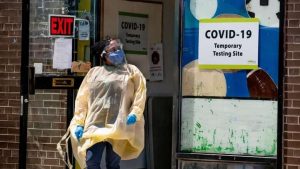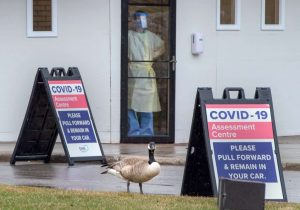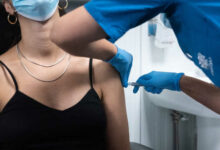New study suggests a tiny fraction of Ontario has been infected with COVID-19

A new study by Public Health Ontario suggests that the number of people who have been infected by COVID-19 in the province has been a tiny fraction of its total population.
The study, entitled “COVID-19 Seroprevalence in Ontario: March 27, 2020 to June 30, 2020,” measured the presence of antibodies against SARS-CoV-2, the virus that causes COVID-19, in blood test samples of people across the province. Public Health Ontario is the province’s public health agency.
From June 5 to 30, the study found 1.1 per cent of the samples were positive for COVID-19 antibodies.
Medical experts say the finding suggests the actual number of COVID-19 cases in Ontario was likely four times higher in June than the official case count.
Dr. Dominik Mertz, associate professor, division of infectious diseases, department of medicine, at McMaster University in Hamilton, said the study shows that people in the province remain at risk of catching the infectious disease.
“Whether it’s one or two per cent or three per cent, it doesn’t really matter in terms of protection,” Mertz told CBC Toronto on Monday.
“It’s still a very small population within Ontario that’s been exposed or has at least for now an immunity, so it shouldn’t change anything in terms of our behaviour. It’s probably not even enough to slow down any further transmission.”
Mertz said Ontario is still doing relatively well compared to some jurisdictions.
Given the numbers, he said people still need to follow public health guidelines and carefully weigh the risks of their activities as they go about their lives, finding a balance between what they need and want to do.

“Nothing will change with this serology data. It just sort of confirms the fact that that we still need to be cautious from that perspective. We don’t have immunity that will protect us,” he said.
Dr. David Fisman, an epidemiologist at the University of Toronto’s Dalla Lana School of Public Health, said the finding means roughly 160,000 people, or 1.1 per cent of Ontario’s population of 15 million, could have been infected in June.
Not everybody who had symptoms could get tested
According to Dr. Vinita Dubey, associate medical officer of health for Toronto Public Health, the study’s findings are similar to that of the Canadian Immunity Task Force, which showed that, out of national blood donor samples, about 1 per cent of the population had COVID-19 antibodies.
Dubey said it is expected that the actual number of infections in Toronto and Ontario is higher than laboratory confirmed cases because not everyone who had symptoms early in the outbreak was eligible for testing.
“In Toronto, despite having over 15,000 laboratory confirmed cases in the city, the actual number of people who got COVID-19 is likely higher as not everyone was tested throughout the course of the outbreak,” Dubey said
“However, well over 95 per cent of the population do not have evidence for COVID-19 antibodies and are susceptible. As well, it is not known yet if those who have COVID-19 antibodies have lifelong immunity. This means that we must all continue our public health measures to prevent the ongoing spread of COVID-19, and we must keep our vulnerable populations protected.”
Blood samples analyzed by age, sex, region
Public Health Ontario says it analyzed the blood samples, which were provided for purposes other than COVID-19 analysis, by age group, sex and Ontario region. The samples were “de-identified” before testing to protect the identity of individuals. The proportion of positive samples varied by geographic region, it said.
The agency said it looked at three specific time periods, March 27 – April 30, May 26 – 31 and June 5 -30, but June had a larger sample size that allowed for more detailed analysis.
“Serological tests can be used to determine the proportion of the population that has been infected with COVID-19; however, they cannot determine current infection or infectivity. Furthermore, at this time the correlation between a positive antibody test and immunity to COVID-19 is unknown,” it said.
“The results of this work will allow us to understand which groups and subgroups in the Ontario population have been infected with COVID-19, and to enhance pandemic prevention and preparedness efforts.”
Public health guidelines in Toronto include maintaining physical distancing, wearing masks in indoor public spaces as well as apartment and condo common areas and washing hands frequently.
CBC








Redes Sociais - Comentários